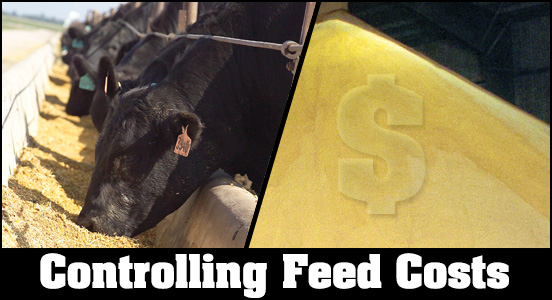HEALTH & NUTRITION...

Distillers' grains spoilage doesn't affect feedlot performance.
As production costs have crept higher and higher, the use of grain-milling byproducts has helped many cattle producers maintain a measure of control over feed costs. Wet distillers' grains with solubles (WDGS) have become a popular ingredient for growing, finishing and cow-wintering rations. Typically considered a challenge to WDGS use, however, is the product's susceptibility to spoilage, particularly during warm weather. Read more.Digital Dermatitis
An emerging condition in feedlot cattle is an unwanted experience.
It's a problem more common to dairy operations, but the beef industry is gaining unwanted experience with digital dermatitis. Iowa State University (ISU) extension veterinarian Jan Shearer calls digital dermatitis an "emerging condition" among feedlot cattle. It can affect breeding stock, too, especially when kept in confinement, but the feedlot is where this malady of many monikers is becoming a significant problem.
Common names include raspberry heel, foot wart and hairy heel wart, but Shearer says digital dermatitis skin lesions really aren't warts. While warts result from viral infections, spirochetes (a type of bacteria) are believed to be the infectious cause of digital dermatitis. However, environmental conditions and animal immune status are thought to be contributing factors. Read more.

Rick Rasby
Ridin’ Herd
Mineral supplementation programs
Commercial cow-calf producers know minerals are important to the animal; many chemical reactions require them to be present. With input costs continually on the rise, the question by producers is what mineral(s) should be the focus, and how can these minerals be provided economically? These are good questions, and they are not easily answered.
Producers note the wide range in cost of the mineral supplementation programs they hear and read about. A mineral program that fills the gaps in minerals needed compared to minerals supplied is only a component of a complete nutrition program that lends itself to production and reproductive performance optimums for a ranch. An understanding of some basic principles will help meet the challenge of selecting a mineral supplementation program. One thing is for certain: No one program fits all production systems. Read more.
Looking for Ways to Control Leptospirosis
It's not often you hear much about leptospirosis, which is a rare and severe disease that affects humans and animals. One reason may be because symptoms can be mistaken for those of other diseases.
Leptospirosis is a contagious disease caused by Leptospira bacteria. It's transmitted naturally from infected domestic animals and wildlife to humans through urine-contaminated water, food or soil. The disease can cause a severe infection in humans. Symptoms include headaches, fever, vomiting, diarrhea and chills. Without treatment, people infected with the disease can suffer from kidney damage, meningitis, liver failure and respiratory distress. Read more.
Developing Heifers:
Cost vs. Performance
Research conducted from the late 1960s to the 1980s showed that heifers reach puberty and conceive only upon attaining a genetically predetermined size. It was generally recommended that heifers reach 60%-65% of expected mature weight before breeding commenced. In order to begin breeding at 14-15 months of age, heifers must gain well to reach that goal, which can involve significant cost.
In a review of research conducted since 2004, the authors concluded that feeding replacement heifers to traditional target weights increased cost without improving reproduction or calf production compared to developing them to 50%-57% of mature weight. It was indicated that the most effective system might involve relatively slow development after weaning, followed by faster gain from 45-60 days before breeding.
Also, there is some indication that genetic selection for calving at 2 years of age (rather than 3, as was once common practice) may have reduced the percentage of mature weight needed to reach puberty. (Univ. of Nebraska, USDA-ARS Miles City, MT; J. Anim. Sci. 90:1166)
A Rough, Tough Forage for Rangeland Cattle
Forage kochia (Kochia prostrata) is a shrubby Asian native that has found a new home on western U.S. rangelands. Although it is not invasive, it is still sometimes more resilient than the North American native plants.
"In some rangeland soils, it's difficult to successfully reseed with native plants," says geneticist Blair Waldron, who works at the Agricultural Research Service's Forage and Range Research Laboratory in Logan, Utah. "But we've shown that forage kochia can be established to enhance rangelands and compete with cheatgrass successfully. It can even protect against wildfires. Some people said that livestock won't eat it, but we've found that cows will graze kochia — and that they even prefer it over lupine, which can be toxic to pregnant cattle." Read more.
Johne's Disease Information Available
The National Johne's Disease Educational Initiative has published the Spring 2012 edition of the Johne's Disease — Beef electronic newsletter. Articles in this edition include
- "Navigating the Maze of Johne's Disease Diagnostic Tests";
- "Vaccine Project Progressing"; and
- "AI, Breeding Season and Johne's Disease Transmission."
Kick-start Respiratory Vaccination at Turnout
Help get calves off to a healthier start with an intranasal vaccine.
Using an intranasal vaccine at branding or summer turnout can help producers prepare calves to kick-start their fight against bovine respiratory disease (BRD), according to Michael Nichols, cattle and equine technical services, Pfizer Animal Health."There are intranasal vaccines that can be used in very young calves," Nichols says. "In fact, an ideal time to use them is at branding or turnout for two major reasons — some intranasal vaccines can help override maternal antibodies present in colostrum and they can help prime the calf's immune system, helping make future vaccinations more effective." Read more.
Cattle Diseases: Common Conditions/Terms
Click here for a list of common conditions and terms related to beef cattle diseases, such as anaplasmosis, brucellosis, BVD, E. coli, IBR and others.
[Click here to go to the top of the page.]











